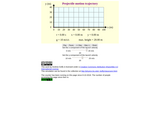
This simulation is about Motion with Constant Acceleration
هذه المحاكاة تشرح عن الحركة مع التسارع المستمر
- Subject:
- Physics
- Science
- Material Type:
- Simulation
- Provider:
- Boston University
- Author:
- Andrew Duffy
- Date Added:
- 06/03/2019

This simulation is about Motion with Constant Acceleration
هذه المحاكاة تشرح عن الحركة مع التسارع المستمر

This single player game helps students develop an understanding of the partial quotient strategy for division. It can also help students develop and understanding of division with and without remainders.

This models Newton's Method using a custom tool.

A visual demo of Newton's Method for pre-calculus students.

This shows how Newton's method (also known as Newton-Raphson) is used to find a root of a function. You can show/hide various parts of the construction, and edit the particular function being considered.

An interactive applet and associated web page that demonstrate obtuse angles (those between 90 and 180 deg). The applet presents an angle (initially obtuse) that the user can adjust by dragging the end points of the line segments forming the angle. As it changes it shows the angle measure and a message that indicate which type of angle it is. There a software 'detents' that make it easy capture exact angles such as 90 degrees and 180 degrees The message and angle measures can be turned off to facilitate classroom discussion. The text on the page has links to other pages defining each angle type in depth. Applet can be enlarged to full screen size for use with a classroom projector. This resource is a component of the Math Open Reference Interactive Geometry textbook project at http://www.mathopenref.com.

This is a collection of outreach resources about the Sun that are meant to be used in informal education settings. This toolkit was originally designed for NASA Night Sky Network member clubs and the Astronomical Society of the Pacific's Astronomy from the Ground Up network of museum and science center educators. The toolkit includes background information about the Sun, magnetic fields of the Earth and Sun, and space weather, activity suggestions, and detailed activity scripts. The themes of this toolkit address both the constant nature of the Sun as a reliable source of energy and the dynamic nature of the Sun due to its changing magnetic fields. The activities and related materials in this collection include The Sun in a Different Light - Observing the Sun, Explore the Sun cards, Magnetic Connection, the Space Weather PowerPoint, Protection from Ultraviolet, and Where Does the Energy Come From cards. These activities can be done separately or as a group as part of an informal education event. Institutions that are not part of the Night Sky Network will need to acquire the various materials required for each activity.

This PBL activity teaches young students about stranger safety. By bringing in a guest speaker to the classroom, having students create their own scenarios and responses, and having them write a letter to someone they want to thank for keeping them safe, this activity allows students to practice their writing and listening skills while learning an important real-life lesson about strangers at the same time.

Students to enter and compare numeric or algebraic expressions in this interactive pan balance, from Illuminations, . They can "weigh" the expressions they want to compare by entering them on either side of the balance, allowing them to practice arithmetic and algebraic skills, as well as to investigate the concept of equivalence.

The interactive pan balance uses multiple shapes with different values, allowing students to investigate what happens as different shapes are placed on the balance. This student interactive, from Illuminations, provides an interesting environment in which students can consider the concept of equivalence.

A web page and interactive applet show how to compute the perimeter of a polygon. A polygon is shown that can be resized by dragging its vertices. As you drag, the perimeter is continuously recalculated. Text on the page explains that the perimeter is the sum of the sides. For those who prefer it, in a formula that is given. Applet can be enlarged to full screen size for use with a classroom projector. This resource is a component of the Math Open Reference interactive geometry reference book project at http://www.mathopenref.com.

Students will create their own sine function to match a picture of mountains. This will teach them what the coefficents of trig functions do.

This Thinglink provides a series of brief videos addressing a) common areas of difficulty related to problem solving and b) an overview of additional and subtraction problem types.

This simulation is about Projectile Motion set initial velocity components
هذه المحاكاة تتعلق بحركة المقذوفات - وآلية تحديد مكونات السرعه الأولية.

This simulation is about Projectile Motion set speed and angle. هذه المحاكاة تتعلق بحركة المقذوفات - السرعه والزاوية

This simulation is about Projectile Motion with motion diagram and velocity components
, هذه المحاكاة تتحدث عن - حركة المقذوفات , مع عناصر الرسم البياني الحركة والسرعه.

This simulation is about Projectile Motion (with motion diagram, velocity components, and graphs,
هذه المحاكاة هي تتحدث عن حركة المقذوفات ومايتعلق بمخطط الحركة، مكوناته والسرعة، والرسوم البيانية

This simulation is showing the Race between a dropped ball and one launched horizontally هذه المحاكاة توضح الفرق بالسرعه بين كرة سقطت من الأعلى الى الأسفل وبين كرة اطلقت من الأسفل الى الأعلى.

An interactive applet and associated web page that show the definition and properties of a rectangle in coordinate geometry. The applet has a rectangle with draggable vertices. As the user re-sizes the rectangle the applet continuously recalculates its width, height and diagonals from the vertex coordinates. Rectangle can be rotated on the plane to show the more complex cases. The grid, coordinates and calculations can be turned on and off for class problem solving. The applet can be printed in the state it appears on the screen to make handouts. The web page has a full definition of a rectangle when the coordinates of the points defining it are known, and has links to other pages relating to coordinate geometry. Applet can be enlarged to full screen size for use with a classroom projector. This resource is a component of the Math Open Reference Interactive Geometry textbook project at http://www.mathopenref.com.

An interactive applet and associated web page that show the relationship between the perimeter and area of a triangle. It shows that a triangle with a constant perimeter does NOT have a constant area. The applet has a triangle with one vertex draggable and a constant perimeter. As you drag the vertex, it is clear that the area varies, even though the perimeter is constant. Optionally, you can see the path traced by the dragged vertex and see that it forms an ellipse. A link takes you to a page where this effect is exploited to construct an ellipse with string and pins. The applet can be enlarged to full screen size for use with a classroom projector. This resource is a component of the Math Open Reference Interactive Geometry textbook project at http://www.mathopenref.com.